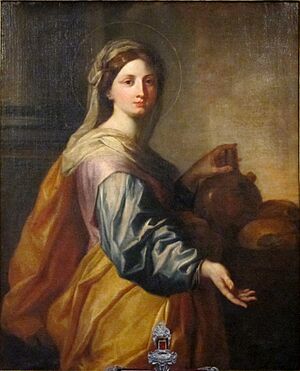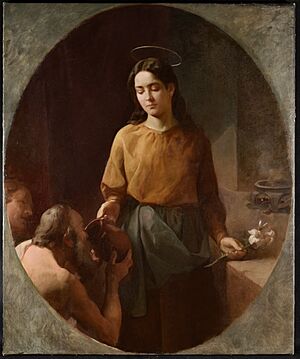Zita facts for kids
Quick facts for kids SaintZita |
|
|---|---|

Arnould de Vuez, Sainte Zite (1696), Hospice Comtesse
|
|
| Virgin | |
| Born | c. 1212 Monte Sagrati, near Lucca, Italy |
| Died | April 27, 1272 (aged 59–60) Lucca, Italy |
| Venerated in | Roman Catholic Church |
| Canonized | 1696 |
| Major shrine | Basilica di San Frediano, Lucca |
| Feast | 27 April |
| Attributes | depicted with a bag, keys |
| Patronage | Domestic servants, homemakers, lost keys, people ridiculed for their piety, single laywomen, waiters, waitresses, Lucca |
Zita (born around 1212, died April 27, 1272) was an Italian saint. She is also known as Sitha or Citha. Zita is the patron saint of maids and people who work in homes. Many people ask for her help when they lose their keys.
Zita started working as a servant when she was 12 years old. She worked for the same family for almost 50 years. She was a very hardworking and loyal servant. Zita was known for her kindness and how much she helped people who were poor. She did everyday tasks very well.
Contents
Zita's Early Life
Zita was born in a village called Monte Sagrati in Tuscany, Italy. This village was close to the city of Lucca. Her parents were Giovanni and Buonissima Lombardo. Zita's uncle, Graziano, was a hermit. A hermit is someone who lives alone, often for religious reasons. He lived on a nearby mountain and built a church and a place for travelers to stay. Zita's older sister became a nun.
When Zita was 12, she began working for the Fatinelli family. They were rich silk merchants. Mrs. Fatinelli let Zita go to school for a year. After that, an older maid trained her. This older maid was jealous of Zita. She tried to make Zita look bad, saying she was lazy or didn't do her work. But Zita never argued or defended herself. Other servants also thought Zita was just pretending to be religious.
How Zita Lived and Worked
Zita was very gentle and humble. Because of this, she was able to overcome the unkindness of the other servants. She gave one-third of her earnings to her parents. She saved one-third for herself. The last third she gave to people who were poor.
The lady of the house, Mrs. Fatinelli, soon trusted Zita a lot. She put Zita in charge of giving alms (money or food) to the poor. Zita was also allowed to visit sick people in their homes. She would help them with what they needed.
Zita had a small room in the house that was separate from the others. She would go out in the evenings and invite poor, homeless women to have supper. She offered them her room, which had a bed, as a safe place to sleep for the night.
Zita always woke up hours before the rest of the family. She made sure to attend church service every morning before starting her work. She did her tasks very carefully and loyally. She also tried to guess what needed to be done next so she could be ready.
When Mrs. Fatinelli was dying, her last wish was for Zita to take charge of the household. Zita continued to serve the family even after Mr. Guglielmo Fatinelli died in 1260. His son, Pagano, then became the head of the family.
Amazing Stories About Zita

People sometimes show Zita in art carrying bread for the poor in her cloak. A cloak is a type of coat. Jealous servants told the master about this. When he asked Zita, she opened her cloak. But instead of bread, it was full of flowers! A similar story is told about Elizabeth of Hungary.
Another time, Zita gave away her own food during a time when there wasn't much food. Then she gave away some food that belonged to her master. When her master asked her about it, they found the pantry (food storage room) was completely full again.
There are different versions of a story about bread. One morning, Zita left her job of baking bread. She either went to help someone in need or was deep in prayer. When she came back, she found the bread loaves already ready in the kneading-trough. Or, in some stories, they were already baked! No one else in the house knew who had prepared the bread. So, people believed angels had done it.
On another day, Zita was returning after giving away alms. She met a beggar. She had nothing left to give him. So, she went with him to the village well to get him a cool drink. She lowered a copper jug into the well. As she held it out to him, she made the sign of the cross over the water. She prayed that the drink would be a blessing for the poor traveler. When he went to drink, he found that the water had turned into wine!
Zita's Death and Honor
Zita died peacefully in the Fatinelli house on April 27, 1272. She was 60 years old. People say that a star appeared above the attic where she slept when she died. She had served the family for 48 years and had become very respected by them.
After Zita's death, many people started to honor her. They believed she helped them. Over 150 miracles were said to happen because of Zita's prayers. The church recognized these miracles. Because of this, she was made a saint in 1696. Her followers gathered at the Basilica of San Frediano in Lucca.
In 1580, Zita's body was dug up. It was found to be incorrupt. This means her body had not decayed. Her body is still on display for people to see and honor in the Basilica di San Frediano in Lucca.
Groups called Guilds were created in Zita's honor. These guilds helped servants who didn't have work. They also cared for servants who were old or very sick. They even honored servants who had worked for a long time.
During the Middle Ages, many people across Europe honored Saint Zita. In England, she was known as Sitha. Maidservants and housewives often asked for her help. This was especially true if they lost keys or were crossing rivers or bridges. You can find pictures of Saint Zita in churches across southern England. Even though she was popular, especially among women, her honor was not officially recognized by the church for a long time.
In the early 1500s, Pope Leo X allowed Zita to be honored in church services. This was confirmed when she became a saint. In 1748, Pope Benedict XIV added her name to the Roman Martyrology. This is a list of saints honored by the Roman Catholic Church.
In 2022, Zita was officially added to the Episcopal Church liturgical calendar. Her feast day is celebrated on April 27.
Zita's Legacy
Zita is the patron saint of people who work in homes, housekeepers, waitresses, and household chores. Her feast day in the Roman Catholic Church is April 27. From 1890 to 2000, a place called St. Zita's Home for Friendless Women in Manhattan helped women who had no home. It gave them food, clothes, shelter, and job training.
Images for kids


